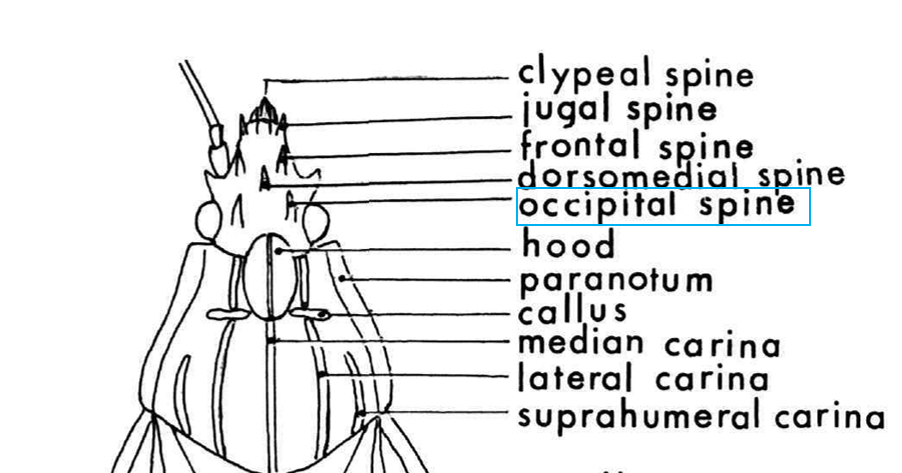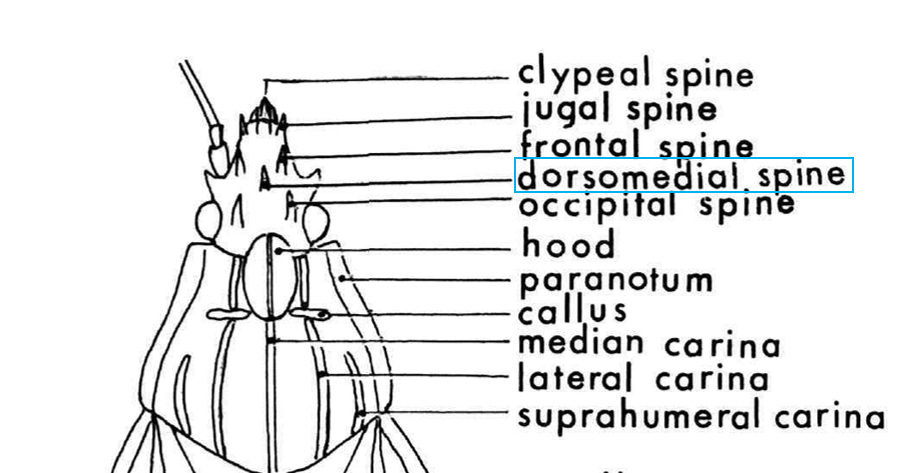Tigava Stål, 1858
Type species: Tigava praecellens Stål
Body narrow and elongate, head short, clypeus not surpassing apical half of first antennal segment; antennae subequal to or shorter than the body, segment I five times or more longer than segment II; cephalic spinescephalic spines:
a spine on the head
 present, confined to occipital spinesoccipital spines:
present, confined to occipital spinesoccipital spines:
a cephalic spine (one of a pair) located on the occiput or arising a short distance forward so as to be between the eyes
 and dorsomedial spinedorsomedial spine:
and dorsomedial spinedorsomedial spine:
a single spine on the midline of the head
 ; bucculaebucculae:
; bucculaebucculae:
an elevated ridge on either side of the first labial segment
 closed anteriorly; rostral sulcusrostral sulcus:
closed anteriorly; rostral sulcusrostral sulcus:
shallow furrow on either side of rostrum (labium)
 parallel, not constricted, uninterrupted by a transverse carinacarina:
parallel, not constricted, uninterrupted by a transverse carinacarina:
elevated ridge or keel
; pronotumpronotum:
dorsal sclerite of the first thoracic segment
tricarinate, lateral carinaecarinae:
elevated ridge or keel
extends throughout the pronotumpronotum:
dorsal sclerite of the first thoracic segment
, height of median carinacarina:
elevated ridge or keel
equal to that of lateral carinae; pronotal hoodhood:
term used to describe the modified anterior area of the pronotum, which is sometimes tectiform and sometimes bulbous, with numerous intermediate conditions.
 tectiform, not bulbous, not extending beyond the apex of head; paranotumparanotum:
tectiform, not bulbous, not extending beyond the apex of head; paranotumparanotum:
lateral extension of pronotum; may be carinate, explanate, or reflexed
 carinate or narrow, with 1-2 rows of areolaeareolae:
carinate or narrow, with 1-2 rows of areolaeareolae:
a small enclosed space on a surface, such as an area enclosed by veinlets on wings
 , not reflexedreflexed:
, not reflexedreflexed:
bent or curved backwards, as in a reflexed paranotum
 , oriented subvertically, spines absent along paranotal margin, anterior margin not projecting anterad; hemelytrahemelytra:
, oriented subvertically, spines absent along paranotal margin, anterior margin not projecting anterad; hemelytrahemelytra:
one of the basally thickened forewings of Hemiptera
with claval areaclaval area:
parallel-sided and sharply pointed anal area of hemelytron
 weakly developed, almost entirely covered by posterior margin of pronotumpronotum:
weakly developed, almost entirely covered by posterior margin of pronotumpronotum:
dorsal sclerite of the first thoracic segment
; costal areacostal area:
area of the costa delineated by the first longitudinal vein of the wing, usually running along the anterior margin
 narrow, with 1-2 rows of areolae; discoidal cell level, short, not reaching the middle of hemelytrahemelytra:
narrow, with 1-2 rows of areolae; discoidal cell level, short, not reaching the middle of hemelytrahemelytra:
one of the basally thickened forewings of Hemiptera
(Montemayor 2008Montemayor 2008:
Montemayor, S. I. 2008. A new genus and two new species of Tingidae (Heteroptera) from Central America. Zoological Science. 25: 444-450., Montemayor and Costa 2009Montemayor and Costa 2009:
Montemayor, S. I., and L. A. a. Costa. 2009. Systematic revision of Macrotingis and phylogenetic analysis of the genera Macrotingis and Ceratotingis (Heteroptera: Tingidae). European Journal of Entomology 106: 631-642., Henry et al. 2017Henry et al. 2017:
Henry, T. J., S. I. Montemayor, and A. H. Knudson. 2017. Review of the New World Tigava lace bug complex (Hemiptera: Heteroptera: Tingidae), with the description of two new genera and two new species and a key to genera. Dugesiana 24: 269-277.).
Nearctic, Neotropical (Mexico to Argentina) (Drake and Ruhoff 1960Drake and Ruhoff 1960:
Drake, C. J., and F. Ruhoff, A. 1960. Lace-bug genera of the world (Hemiptera: Tingidae). Proceedings of the United States National Museum 112., Guilbert 2019Guilbert 2019:
Guilbert, E. 2019. Lace bugs database - http://www.hemiptera-databases.com/tingidae, Knudson 2018Knudson 2018:
Knudson, A. H. 2018. The Tingidae (Hemiptera: Heteroptera) of southern Central America (with an emphasis on Costa Rica). Master#39;s thesis. North Dakota University. https://library.ndsu.edu/ir/handle/10365/28773)
| Intercepted species | Shipment origin(s) | Inspected host(s) |
|---|---|---|
| Tigava pulchella Distant | Mexico | Persea americana |
Drake and Ruhoff 1960Drake and Ruhoff 1960:
Drake, C. J., and F. Ruhoff, A. 1960. Lace-bug genera of the world (Hemiptera: Tingidae). Proceedings of the United States National Museum 112., Guilbert 2019Guilbert 2019:
Guilbert, E. 2019. Lace bugs database - http://www.hemiptera-databases.com/tingidae, Henry et al. 2017Henry et al. 2017:
Henry, T. J., S. I. Montemayor, and A. H. Knudson. 2017. Review of the New World Tigava lace bug complex (Hemiptera: Heteroptera: Tingidae), with the description of two new genera and two new species and a key to genera. Dugesiana 24: 269-277., Knudson 2018Knudson 2018:
Knudson, A. H. 2018. The Tingidae (Hemiptera: Heteroptera) of southern Central America (with an emphasis on Costa Rica). Master#39;s thesis. North Dakota University. https://library.ndsu.edu/ir/handle/10365/28773, Montemayor 2008Montemayor 2008:
Montemayor, S. I. 2008. A new genus and two new species of Tingidae (Heteroptera) from Central America. Zoological Science. 25: 444-450., Montemayor and Costa 2009Montemayor and Costa 2009:
Montemayor, S. I., and L. A. a. Costa. 2009. Systematic revision of Macrotingis and phylogenetic analysis of the genera Macrotingis and Ceratotingis (Heteroptera: Tingidae). European Journal of Entomology 106: 631-642.